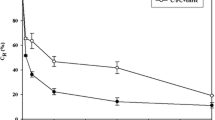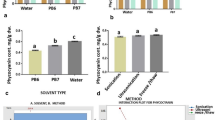Abstract
Phycocyanin, a blue pigment, is a type of phycobiliproteins. Because of its various potential properties, phycocyanin is applied to various fields, such as nutraceutical, pharmaceutical, medicine, cosmetics, and biotechnological research. The cost and application of phycocyanin are highly dependent on its purity index. In this study, ammonium chloride is presented as a novel, effective, and inexpensive salt for phycocyanin extraction. Compared with sodium phosphate, which is commonly used during phycocyanin extraction process, ammonium chloride solution efficiently extracted phycocyanin with high purity from Arthrospira platensis FACHB-314. In addition, ammonium phosphate solution is also presented as an alternative precipitation agent in phycocyanin purification that may replace the widely used ammonium sulfate. Statistical analysis shows that there is no significant difference in phycocyanin concentration between crude extracts (overall mean of 0.208 and 0.215 for extraction using sodium phosphate and ammonium chloride, respectively). However, the difference in phycocyanin purity ratio (A620/A280) between these two extractions is significant (overall mean of 0.742 and 1.428 for extraction using sodium phosphate and ammonium chloride, respectively). With ammonium chloride, the purity indexes of phycocyanin are 1.5 and 2.81 after the optimum extraction step, and precipitation used as the primary purification step, respectively. The present study describes a novel purification method to achieve phycocyanin with analytical grade without multiple purification steps.







Similar content being viewed by others
References
Aiba S, Ogawa T (1977) Assessment of growth yield of a blue—green alga, Spirulina platensis, in axenic and continuous culture. J Gen Microbiol 102:179–182
Baldwin RL (1996) How Hofmeister ion interactions affect protein stability. Biophys J 71:2056–2063
Bennett A, Bogorad L (1973) Complementary chromatic adaptation in a filamentous blue-green alga. J Cell Biol 58:419–435
Borowitzka MA (2013) High-value products from microalgae—their development and commercialisation. J Appl Phycol 25:743–756
Colla LM, Oliveira Reinehr C, Reichert C, Costa JAV (2007) Production of biomass and nutraceutical compounds by Spirulina platensis under different temperature and nitrogen regimes. Bioresource Technol 98:1489–1493
Eithar E-M (2014) Efficient methods for fast, producible, C-phycocyanin from Thermosynechococcus elongatus. J Res Biol 3:1132–1146
Eriksen NT (2008) Production of phycocyanin—a pigment with applications in biology, biotechnology, foods and medicine. Appl Microbiol Biot 80:1–14
Fernández-Rojas B, Hernández-Juárez J, Pedraza-Chaverri J (2014) Nutraceutical properties of phycocyanin. J Funct Foods 11:375–392
Hemlata GP, Fareha B (2011) Studies on Anabaena sp. nccu-9 with special reference to phycocyanin. J Algal Biomass Util 2:30–51
Hoseini S, Khosravi-Darani K, Mozafari M (2013) Nutritional and medical applications of Spirulina microalgae. Mini Rev Med Chem 13:1231–1237
Kamble SP, Gaikar RB, Padalia RB, Shinde KD (2013) Extraction and purification of C-phycocyanin from dry Spirulina powder and evaluating its antioxidant, anticoagulation and prevention of DNA damage activity. J Appl Pharmaceut Sci 3:149–153
Kannaujiya VK, Sinha RP (2016) Thermokinetic stability of phycocyanin and phycoerythrin in food-grade preservatives. J Appl Phycol 28:1063–1070
Kumar D, Dhar DW, Pabbi S, Kumar N, Walia S (2014) Extraction and purification of C-phycocyanin from Spirulina platensis (CCC540). Indian J Plant Physiol 19:184–188
Lezin G, Kuehn MR, Brunelli L (2011) Hofmeister series salts enhance purification of plasmid DNA by non-ionic detergents. Biotechnol Bioeng 108:1872–1882
Liu Y, Xu L, Cheng N, Lin L, Zhang C (2000) Inhibitory effect of phycocyanin from Spirulina platensis on the growth of human leukemia K562 cells. J Appl Phycol 12:125–130
Manirafasha E, Ndikubwimana T, Zeng X, Lu Y, Jing K (2016) Phycobiliprotein: potential microalgae derived pharmaceutical and biological reagent. Biochem Eng J 109:282–296
Martelli G, Folli C, Visai L, Daglia M, Ferrari D (2014) Thermal stability improvement of blue colorant C-phycocyanin from Spirulina platensis for food industry applications. Process Biochem 49:154–159
Moraes C, Sala L, Cerveira G, Kalil S (2011) C-phycocyanin extraction from Spirulina platensis wet biomass. Braz J Chem Eng 28:45–49
Moraes CC, Kalil SJ (2009) Strategy for a protein purification design using C-phycocyanin extract. Bioresource Technol 100:5312–5317
Parmar A, Singh NK, Pandey A, Gnansounou E, Madamwar D (2011) Cyanobacteria and microalgae: a positive prospect for biofuels. Bioresource Technol 102:10163–10172
Patel A, Mishra S, Pawar R, Ghosh P (2005) Purification and characterization of C-phycocyanin from cyanobacterial species of marine and freshwater habitat. Protein Expres Purif 40:248–255
Patil G, Raghavarao KSMS (2007) Aqueous two phase extraction for purification of C-phycocyanin. Biochem Eng J 34:156–164
Reis A, Mendes A, Lobo-Fernandes H, Empis JA, Novais JM (1998) Production, extraction and purification of phycobiliproteins from Nostoc sp. Bioresource Technol 66:181–187
Rito-Palomares M, Nuñez L, Amador D (2001) Practical application of aqueous two-phase systems for the development of a prototype process for c-phycocyanin recovery from Spirulina maxima. J Chem Technol Biot 76:1273–1280
Sagara T, Nishibori N, Kishibuchi R, Itoh M, Morita K (2015) Non-protein components of Arthrospira (Spirulina) platensis protect PC12 cells against iron-evoked neurotoxic injury. J Appl Phycol 27:849–855
Santiago-Santos MC, Ponce-Noyola T, Olvera-Ramı́rez R, Ortega-López J, Cañizares-Villanueva RO (2004) Extraction and purification of phycocyanin from Calothrix sp. Process Biochem 39:2047–2052
Setyoningrum Tutik M, Nur MMA (2015) Optimization of C-phycocyanin production from S. platensis cultivated on mixotrophic condition by using response surface methodology. Biocatal Agricult Biotechnol 4:603–607
Sigma-Aldrich (2016) http://www.sigmaaldrich.com/catalog/search?&interface=All&N=0+14577477&mode=partialmax&lang=en®ion=SG&focus=product. Accessed 12 March 2016
Sobiechowska-Sasim M, Stoń-Egiert J, Kosakowska A (2014) Quantitative analysis of extracted phycobilin pigments in cyanobacteria—an assessment of spectrophotometric and spectrofluorometric methods. J Appl Phycol 26:2065–2074
Soni B, Trivedi U, Madamwar D (2008) A novel method of single step hydrophobic interaction chromatography for the purification of phycocyanin from Phormidium fragile and its characterization for antioxidant property. Bioresource Technol 99:188–194
Su C-H, Liu C-S, Yang P-C, Syu K-S, Chiuh C-C (2014) Solid–liquid extraction of phycocyanin from Spirulina platensis: kinetic modeling of influential factors. Sep Purif Technol 123:64–68
Sun L, Wang S, Gong X, Zhao M, Fu X, Wang L (2009) Isolation, purification and characteristics of R-phycoerythrin from a marine macroalga Heterosiphonia japonica. Protein Expres Purif 64:146–154
Ullah K, Ahmad M, Sofia SVK, Lu P, Harvey A, Zafar M, Sultana S, Anyanwu CN (2014) Algal biomass as a global source of transport fuels: overview and development perspectives. Prog Nat Sci 24:329–339
Walter A, Carvalho JC, Soccol VT, Faria ABB, Ghiggi V, Soccol CR (2011) Study of phycocyanin production from Spirulina platensis under different light spectra. Braz Arch Biol Technol 54:675–682
Wang Z, Zhang X (2016) Characterization and antitumor activity of protein hydrolysates from Arthrospira platensis (Spirulina platensis) using two-step hydrolysis. J Appl Phycol. 28:3379–3385
Wang WJ, Zhang XL, Xu CB, Cheng HY (2012) Purification and concentration of C-phycocyanin from Spirulina platensis using aqueous two-phase system. Appl Mech Mater 138-139:995–1001
Wojtasiewicz B, Stoń-Egiert J (2016) Bio-optical characterization of selected cyanobacteria strains present in marine and freshwater ecosystems. J Appl Phycol 28:2299–2314
Xia D, Liu B, Xin W, Liu T, Sun J, Liu N, Qin S, Du Z (2016) Protective effects of C-phycocyanin on alcohol-induced subacute liver injury in mice. J Appl Phycol 28:765–772
Xie Y, Jin Y, Zeng X, Chen J, Lu Y, Jing K (2014) Fed-batch strategy for enhancing cell growth and C-phycocyanin production of Arthrospira (Spirulina) platensis under phototrophic cultivation. Bioresource Technol 180:281–287
Zhang Y, Cremer PS (2006) Interactions between macromolecules and ions: the Hofmeister series. Curr Opin Chem Biol 10:658–663
Acknowledgments
The authors are grateful to the Government of Rwanda through University of Rwanda-College of Education for giving a Ph.D. study leave to Mr. Manirafasha Emmanuel and the Government of People’s Republic of China for financially supporting his Ph.D. studies. This work was supported by the National Natural Science Foundation of China (No. 31071488), the National High Technology Research and Development Program 863, China (No. 2014AA021701), and the State Key Program of National Natural Science Foundation of China (No. 21336009).
Author information
Authors and Affiliations
Corresponding authors
Rights and permissions
About this article
Cite this article
Manirafasha, E., Murwanashyaka, T., Ndikubwimana, T. et al. Ammonium chloride: a novel effective and inexpensive salt solution for phycocyanin extraction from Arthrospira (Spirulina) platensis . J Appl Phycol 29, 1261–1270 (2017). https://doi.org/10.1007/s10811-016-0989-y
Received:
Revised:
Accepted:
Published:
Issue Date:
DOI: https://doi.org/10.1007/s10811-016-0989-y




